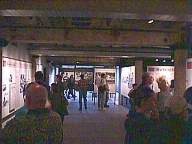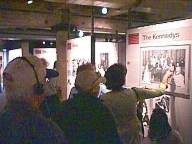A Day to
Remember
Texas School Book
Depository
Dallas,
Texas
March 16, 2000
"So where
were you when Kennedy was assassinated?" For years after
that fateful day in 1963, it was a common question at parties and
gatherings throughout the world. I was sitting on the floor of an
apartment on Lafayette St. in Cincinnati, surrounded by three
lovely girls, enjoying my second day of a three day furlough,
while doing a four year stretch in the Air Force. I actually
remember the pressured voice of the announcer who "broke
in" to the broadcast with a special announcement. I mostly
remember it because of the ending statement made by the
announcer. "A National Emergency exists and all military
leave has been canceled. All military personnel are to report
immediately to their respective stations", or something to
that effect. It was a day that touched many people in many ways.
where
were you when Kennedy was assassinated?" For years after
that fateful day in 1963, it was a common question at parties and
gatherings throughout the world. I was sitting on the floor of an
apartment on Lafayette St. in Cincinnati, surrounded by three
lovely girls, enjoying my second day of a three day furlough,
while doing a four year stretch in the Air Force. I actually
remember the pressured voice of the announcer who "broke
in" to the broadcast with a special announcement. I mostly
remember it because of the ending statement made by the
announcer. "A National Emergency exists and all military
leave has been canceled. All military personnel are to report
immediately to their respective stations", or something to
that effect. It was a day that touched many people in many ways.
Some 37 years later, my
wife and I found ourselves standing at Elm and Houston, in
downtown Dallas, looking up at the sixth floor of the building at
411 Elm. Now called The Dallas County Administration Building, it
will remain forever in the minds of many Dallas residents, and
others around the world, as the "Texas School Book
Depository".
later, my
wife and I found ourselves standing at Elm and Houston, in
downtown Dallas, looking up at the sixth floor of the building at
411 Elm. Now called The Dallas County Administration Building, it
will remain forever in the minds of many Dallas residents, and
others around the world, as the "Texas School Book
Depository".
I remember 1963 as a tremulous year, conflict and crisis seemed
to be everywhere. The civil rights movement was at its pinnacle.
President John F. Kennedy needed the southern vote in the coming
election year and decided to campaign in Texas in November. That
same month, a quite unobtrusive man named Lee Harvey Oswald took
a job with the Texas School Book Depository Co. On November 22nd,
an estimated 200,000 people greeted the presidential motorcade as
it passed through downtown Dallas, on its way to a sold-out
luncheon at the Trade Mart. On that day, Abraham Zapruder, played with his new Bell and Howell Model
414PD 8 mm camera. As the presidential caravan approached,
Abraham climbed up upon a concrete abutment and switching his
Varamat zoom lens to close-up, turned his camera toward the
presidential procession. At 12:30, the limousine carrying Kennedy
and Governor John B. Connally of Texas turned west off Houston and
onto Elm. Seconds later, at least 3 shots rang out and John F.
Kennedy slumped forward. With the grand reception just minutes
away, all reporters were gathered at the Trade Mart. Abraham
Zapruder would enter the history books as the only person to have
filmed the entire assignation close up. A fact that would change
his life. The story of that 10 second film, and the camera that
was used is, in itself, a study in history. Between pressure from
the media and the demands
with his new Bell and Howell Model
414PD 8 mm camera. As the presidential caravan approached,
Abraham climbed up upon a concrete abutment and switching his
Varamat zoom lens to close-up, turned his camera toward the
presidential procession. At 12:30, the limousine carrying Kennedy
and Governor John B. Connally of Texas turned west off Houston and
onto Elm. Seconds later, at least 3 shots rang out and John F.
Kennedy slumped forward. With the grand reception just minutes
away, all reporters were gathered at the Trade Mart. Abraham
Zapruder would enter the history books as the only person to have
filmed the entire assignation close up. A fact that would change
his life. The story of that 10 second film, and the camera that
was used is, in itself, a study in history. Between pressure from
the media and the demands  of
the government, it was soon out of Abraham's hands. The film
would become one of the most studied and interpreted pieces of
cellulose ever recorded. Rather than clarify the event, it would
eventually become the focal point of the "conspiracy"
theory. Big media was quick to focus on anything that was
controversial. Government, on the other hand demanded answers. By
1964, a congressional commission was appointed to be headed by
Justice Earl Warren of the Supreme Court, which is now known as
the Warren Commission. "Who shot JFK" became the
decade's most challenging question. Today there is still no
definitive answer. Some things are clear and accepted. Lee Harvey
Oswald, fired a fatal shot at President John F. Kennedy from the
southeast corner window on the sixth floor of the Texas School
Book Depository Co. building. That window, that floor, that
building, is now and forever cast, for better or worse, into the
history and fabric of this great country. After the shooting, the
infamous building would
of
the government, it was soon out of Abraham's hands. The film
would become one of the most studied and interpreted pieces of
cellulose ever recorded. Rather than clarify the event, it would
eventually become the focal point of the "conspiracy"
theory. Big media was quick to focus on anything that was
controversial. Government, on the other hand demanded answers. By
1964, a congressional commission was appointed to be headed by
Justice Earl Warren of the Supreme Court, which is now known as
the Warren Commission. "Who shot JFK" became the
decade's most challenging question. Today there is still no
definitive answer. Some things are clear and accepted. Lee Harvey
Oswald, fired a fatal shot at President John F. Kennedy from the
southeast corner window on the sixth floor of the Texas School
Book Depository Co. building. That window, that floor, that
building, is now and forever cast, for better or worse, into the
history and fabric of this great country. After the shooting, the
infamous building would  change
hands several times and finally fall into disrepair. Controversy
would continue as to what was to be done with it. There were
those who desired it be torn down, but Dallas refused to issue a
demolition permit and the building continued to deteriorate. Then
in 1977 the city passed a bond issue which included $400,000 to purchase the building. After that the first 5 floors
were converted into office space and the county administration
moved in. The 6th floor would remained closed to the public. The
next 11 years saw a continuously increasing amount of traffic, as
visitors continued to flock to the building to look up at the
infamous window. In 1988 another bond issue was passed
change
hands several times and finally fall into disrepair. Controversy
would continue as to what was to be done with it. There were
those who desired it be torn down, but Dallas refused to issue a
demolition permit and the building continued to deteriorate. Then
in 1977 the city passed a bond issue which included $400,000 to purchase the building. After that the first 5 floors
were converted into office space and the county administration
moved in. The 6th floor would remained closed to the public. The
next 11 years saw a continuously increasing amount of traffic, as
visitors continued to flock to the building to look up at the
infamous window. In 1988 another bond issue was passed to create a visitors
center with an external elevator to transport people to the 6th
floor. Today over 450,000 visitors a year come to see the
exhibits and peer out the window next to the corner window which
is glassed in. The "Sixth Floor Museum at Dealey Plaza"
is now administered to by a non-profit organization established
in 1983. The foundation opened the museum on Presidents' Day,
February 20, 1989. The 9000 square foot museum contains nearly
400 historic photographs, six documentary files, an audio tour
and a range of artifacts and interpretive displays to document
the life, times, death and legacy of President John F. Kennedy.
to create a visitors
center with an external elevator to transport people to the 6th
floor. Today over 450,000 visitors a year come to see the
exhibits and peer out the window next to the corner window which
is glassed in. The "Sixth Floor Museum at Dealey Plaza"
is now administered to by a non-profit organization established
in 1983. The foundation opened the museum on Presidents' Day,
February 20, 1989. The 9000 square foot museum contains nearly
400 historic photographs, six documentary files, an audio tour
and a range of artifacts and interpretive displays to document
the life, times, death and legacy of President John F. Kennedy.
First of all you have to understand that there were signs up all
over "No pictures." That usually means we smile
politely and leave. After talking with Bob Porter, the Director
of Communications and explaining what it is that we do, he graciously allowed us to
take pictures, with the understanding that we would not interfere
with any of the other visitors, which we, of course, agreed to
do. That is something we try to do anyway when we visit
somewhere. I don't think there is anything more annoying than
someone who blocks everyone's way just to get "the perfect
picture." We have found that if we have patience and wait,
usually we can get just the picture we want without interfering
with anyone else.
explaining what it is that we do, he graciously allowed us to
take pictures, with the understanding that we would not interfere
with any of the other visitors, which we, of course, agreed to
do. That is something we try to do anyway when we visit
somewhere. I don't think there is anything more annoying than
someone who blocks everyone's way just to get "the perfect
picture." We have found that if we have patience and wait,
usually we can get just the picture we want without interfering
with anyone else.
Bob, likes to look at the technical end of things and I usually
end up looking at the emotional. Well, this museum was no
different. We went inside and up in the elevator to where the
main exhibits were located. As we stepped off the elevator I
could feel my stomach muscles tighten and hear myself thinking
"Wow! I'm really here. This is where Oswald (if it was
Oswald that shot Kennedy) stood when he shot HIM." For any
of us who were old enough to remember the events, and feelings,
of that day, it was a very emotional memory.  Sometimes when feelings
like these well up in me, I try to keep them under wraps thinking
that I should be more adult and not show my feelings. Folks, I
want to tell you in that Museum I was not alone. The strange
thing was, there were people there who weren't even old enough to
remember, but were moved to tears by the many exhibits, pictures,
and audio presentations. One lady in particular I saw with a
tissue constantly in her hand. I went over and introduced myself
and asked if we could photograph her. I found out that her name
was Jean Hurdle and she was from Richmond, Texas. At first she
was a little reluctant, because she felt she was making a fool
out of herself. When I pointed out that she wasn't the only one
with tears running down her cheeks she allowed us to take her
picture. I realize that the way the presentations were done had
something to do with it, but I think in general the people were
crying for the terrible loss suffered not only by the Kennedy
family but us as a nation. If you ever go, be sure and take lots
of tissues with you. Don't want to give any family secrets away
but I could have sworn I saw some moisture in my hubby's eyes as
well.
Sometimes when feelings
like these well up in me, I try to keep them under wraps thinking
that I should be more adult and not show my feelings. Folks, I
want to tell you in that Museum I was not alone. The strange
thing was, there were people there who weren't even old enough to
remember, but were moved to tears by the many exhibits, pictures,
and audio presentations. One lady in particular I saw with a
tissue constantly in her hand. I went over and introduced myself
and asked if we could photograph her. I found out that her name
was Jean Hurdle and she was from Richmond, Texas. At first she
was a little reluctant, because she felt she was making a fool
out of herself. When I pointed out that she wasn't the only one
with tears running down her cheeks she allowed us to take her
picture. I realize that the way the presentations were done had
something to do with it, but I think in general the people were
crying for the terrible loss suffered not only by the Kennedy
family but us as a nation. If you ever go, be sure and take lots
of tissues with you. Don't want to give any family secrets away
but I could have sworn I saw some moisture in my hubby's eyes as
well.